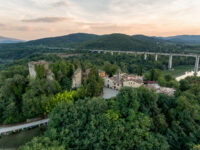
Innovation Beyond Peacebuilding
This is the first of two blog posts on innovation in peacebuilding.
They probably should have been written in the opposite order, because this week’s post deals with innovations beyond peacebuilding while next week’s will consider some important new ideas within it.
However, the world conspired against my best intentions, since the two events described here occurred before I head off to Oman for a small workshop on spiritual approaches to reconciliation at the Al Amana Centre for building trust and peace, especially across religious lines.
Here, I want to talk about two events that took place last week that helped me see some important directions we could and should heading in.
Rondine
First, Franco Vaccari and some of his teammate’s from Rondine, Cittadella della pace paid a visit to George Mason’s School of Conflict Analysis and Resolution. Since I wrote about it after my visit to Rondine over the summer, I’ll spare you the details of what Marco said about the program in general.
At the time, the Cittadella della Pace owned the entire village other than its thirteenth century castle which you can barely see in this picture. Now, it has acquired the castle.
It is beginning to make plans for an innovation lab and business school that should open in 2021. For someone who is steeped in the lore of Silicon Valley garages and skunkworks, the notion of having that kind of incubator in a centuries-old castle makes me smile.
And, it convinced the folks I’m about to describe that we should do what we can to help them make it happen, since it would be great to have a self-sustaining peace industrial complex!
Innovation Beyond Peacebuilding
The Rondine visit had initially been planned for October but had been put off for a few weeks. The luck of the calendrial draw meant that it was held the night before I organized a brownbag in the same conference room with three of my friends who just happened to be in town. Three of the four of us had met with the Rondine team the day before, so we were primed to take that discussion farther, which you can see most easily in a description of my three friends and their projects.
Linton Wells is the driving force behind GMU’s The Center for Resilient and Sustainable Communities (CRASC) which will build partnerships that enhance a community’s ability to absorb disruptions and emerge stronger. Wells first came up with the idea while serving as a career naval officer, a senior Pentagon official, and professor at the National Defense University when he got to know the peacebuilding community. When he originally came up with the idea that became CRASC, he was interested in conflict zones around the world. He actually has gotten it started in West Virginia and Puerto Rico where his team discovered that such local efforts have to deal with a wide range of issues and be locally led.
Chris Langdon is co founder of Thinking the Unthinkable. He and Nik Gowing initially set out to research why high level leaders in the public and private sector were unable to cope with the accelerating changes of our globalizing world. To their surprise, they discovered that leaders that listened to and learned from younger members of their staff actually were doing rather well. They are in the process of turning what started as a research project into a new kind of consulting firm that will help organizations and their leaders navigate today’s troubles “seas.”
Robert Gehorsam is a veteran of the gaming and technology industries whose interest in social change and peacebuilding have grown since the 9/11 attacks which took place in his neighborhood—lower Manhattan. He came to me with the idea of using virtual reality. Put simply by someone who has no experience with VR, Robert would like to design educational experiences that include challenges aimed at the gaming and similar audiences that would help participants come up with ways of dealing with climate change, inequality, and conflict. Drawing on his work with the mindfulness community, he is hoping that we can also develop experiences that have a lasting impact in ways that literally “rewire the brain.”
Because everyone who presented at the two sessions at George Mason was male and over sixty, I asked two young women—a student and a full time researcher—to respond to what Lin, Chris, and Robert had to say.
One of them suggested that we had to get better at what she called her generation’s best way of communicating—uploading and sharing.
I have to admit that I’m not bad at uploading. However, I don’t spend enough time reading what crosses my various social media screens, let along sharing that material with my own network.
In other words, I have a lot to learn.
On to Oman
That learning will have to wait until I get back from Oman.
I will write post on that shortly after I get back and then take a few days off with my grandkids—my six year old granddaughter expects me to bring her back a camel.
The views and opinions expressed in this article are those of the author and do not necessarily reflect the official policy or position of the Alliance for Peacebuilding or its members
Also published on Medium.




